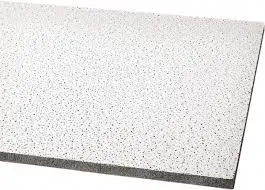Dec . 06, 2024 13:30 Back to list
laminated gypsum
Understanding Laminated Gypsum A Versatile Building Material
Laminated gypsum, often referred to as gypsum board or drywall, is a staple material in the construction industry. Its widespread use can be attributed to its unique properties, versatility, and efficiency in building applications. To fully appreciate laminated gypsum, it is essential to explore its composition, benefits, installation processes, and environmental impact.
Composition and Structure
Laminated gypsum consists of a core made of gypsum plaster sandwiched between two layers of heavy paper or fiberglass. This structure gives the material its strength while maintaining a lightweight profile. The core is primarily composed of calcium sulfate dihydrate, which is a naturally occurring mineral. The paper facing is often treated to improve moisture resistance, making laminated gypsum suitable for a variety of environments, including residential, commercial, and industrial applications.
Key Benefits
1. Fire Resistance One of the most compelling advantages of laminated gypsum is its inherent fire-resistant qualities. Gypsum contains water molecules that, when exposed to heat, release steam, helping to slow the spread of flames. This characteristic makes laminated gypsum a popular choice for fire-rated assemblies in buildings, providing critical minutes for occupants to escape in case of a fire.
2. Sound Insulation Laminated gypsum also excels in soundproofing capabilities. The material effectively dampens noise, providing a quieter indoor environment. This property is particularly important in multi-family residences, offices, and educational institutions, where sound control is crucial for privacy and comfort.
3. Ease of Installation Compared to traditional wall materials such as plaster or concrete, laminated gypsum is easier and quicker to install. It can be cut, shaped, and adjusted to fit a wide range of configurations, significantly reducing labor time and costs. Furthermore, it can be finished with paint or wallpaper, allowing for versatile aesthetic applications in interior design.
laminated gypsum

4. Cost-Effective Laminated gypsum is generally more affordable than many other building materials. Its availability and ease of handling contribute to lower overall project costs, making it a budget-friendly option for builders and homeowners alike.
Installation Process
The installation of laminated gypsum is straightforward. First, the framing of the wall or ceiling is constructed, usually with wooden or metal studs. The gypsum boards are then cut to size and attached to the framing using screws or nails. Joints between the sheets are filled with joint compound and sanded for a smooth finish. Once the finishing touches are applied, the surface is ready for painting or decoration.
Environmental Considerations
As the construction industry increasingly focuses on sustainability, laminated gypsum has made significant strides. Many manufacturers now produce eco-friendly versions of gypsum board using recycled materials and reducing emissions during production. Additionally, gypsum is a non-toxic mineral, making it a safer choice for indoor air quality compared to other materials that may release harmful chemicals.
Conclusion
Laminated gypsum stands out as a reliable and multifunctional building material, offering numerous benefits that make it a favorite among architects, builders, and homeowners. Its fire resistance, sound insulation, ease of installation, and cost-effectiveness contribute to its popularity in modern construction projects. As sustainability becomes a growing concern, the eco-friendly developments in the production of laminated gypsum reflect the industry's commitment to reducing environmental impact. As we continue to innovate in building materials, laminated gypsum remains a cornerstone of efficient and safe construction practices, cementing its place in our built environment for years to come.
-
Durable Ceiling T Grid Systems | Easy InstallationNewsAug.29,2025
-
PVC Gypsum Ceiling: Durable, Laminated Tiles for Modern SpacesNewsAug.28,2025
-
Pvc Gypsum Ceiling Is DurableNewsAug.21,2025
-
Mineral Fiber Board Is DurableNewsAug.21,2025
-
Ceiling Tile Clip Reusable DesignNewsAug.21,2025
-
Ceiling T Grid Modular DesignNewsAug.21,2025







